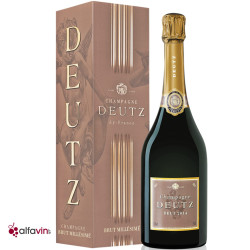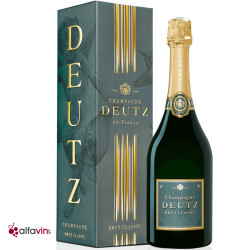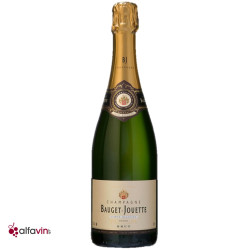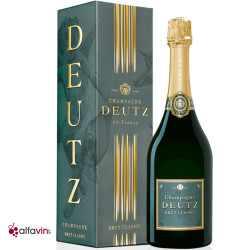- Home >
- Blog >
- advice-champagne-sparkling-wines >
- Sparkling wines & Champagnes
Champagne, sparkling, cremant, sparkling, effervescent, Prosecco and many others... In the category of bubbly wines, the terms are numerous and we often tend to get lost in this multitude of denominations, especially since according to the type of wine chosen, the methods of elaboration are not the same, the prices and their differences can be significant, sometimes doubling or even more for some. In order to help you find the wine you want, Alfavin.ch explains this category in a little more detail so that you can first understand what we are talking about and then guide you on your next purchases.
What is a sparkling wine?
In the purely technical definition, a sparkling wine is a category of wines, grouped under the family of sparkling wines, which are opposed to the family of so-called "still" wines. There are 3 types of wines: sparkling wines, semi-sparkling wines and sparkling wines. The perlants are slightly gaseous bottled wines whose principle of wine making makes them "pearl". Sparkling wines are sparkling wines whose carbon dioxide content is higher than the first ones, which generally corresponds to a pressure of between 1 and 2.5 bars. Finally, sparkling wines are those with the highest carbon dioxide content and a pressure higher than 3 bars. Champagne and crémant are found in this category.
What are the differences between a sparkling wine and a champagne?
Strictly speaking, there is no difference since Champagne is a sparkling wine. However, the image of Champagne wines is so strong that today in the consumer's mind, there is champagne and sparkling wine. A question that could be asked is "what is the difference between a champagne and a crémant" for example.
In order to better understand sparkling wines, let's take a closer look at the different methods of making these wines, including the "prise de mousse" stage. The best known of these methods is the traditional method, also known as the méthode champenoise. This method consists of a first fermentation as for any other wine and then a second fermentation in the bottle that triggers the foam. There is also the ancestral method which is also called artisanal, gaillacoise, limouxine. This method consists in bottling the wines while the alcoholic fermentation is not finished. The wines are thus locked up with natural sugars, yeasts; the end of the alcoholic fermentation will produce CO2 which will give this effervescence. Another possible method is the Charmat method. For the record, this method was invented in 1895 by Federico Martinotti but it was Jean-Eugène Charmat who was the first to obtain the patent in 1907. This process consists in making the foam in hermetically sealed tanks under high pressure. The basic wines chosen to make the sparkling wines are mixed with yeast and a fermentation liquor (a mixture of sugars and wines).
Beyond the method of production, there is another notable difference between Champagne and other sparkling wines. The wines of Champagne not only enjoy an international aura but are also protected more than any other wine in the world. A Champagne can only be produced in the area delimited by the decree, the harvest must be manual, the pressing (step of wine making) is specific and very precise. Here are some of the rules that make this wine, a wine apart, definitely. Often, the specifications of other wines are not as restrictive.
How to choose a quality sparkling wine and champagne?
To this question, there is a parameter to take into account, do I buy this sparkling wine/champagne during a tasting or is it a direct purchase without tasting. If you do not taste the product, the advice we can give you is to rely on tasting notes, specialized magazines such as "La Revue des Vins de France", medals obtained by the producers. On the tasting side, follow the tasting steps step by step. Visually, the bubbles must be present; the finer they are, the better the wine; the effervescence must be continuous. On the nose, the wine should be pleasant, you should be able to smell the aromas. Some wines develop notes of white fruits while others have toasted, brioche notes, for example. If you taste sparkling wines with notes of oxidation, or a very green side, the wines are past their prime or they are too acidic and lack aromatic maturity. On the palate, the wines should have a pleasant and delicate bubble, a good acidity-alcohol balance and expressive aromas.
How long can you keep champagne?
There is no truth in this matter but rather principles.
A classic cuvée can be kept for 2 to 3 years while the great cuvées can be kept for 5 to 7 years or even more. The question you have to ask yourself is what kind of consumer you are and how you like sparkling wines. If you prefer fresh fruit notes and lively bubbles, drink them quickly. On the other hand, if you like champagnes with more evolved aromas, more vinous and round in the mouth, with notes of undergrowth and spices, wait a little while before tasting your bottles.
How to store a sparkling wine ?
As for any other wine, there are some conditions to respect to keep your sparkling wine at its best. One of the first rules is to
keep your sparkling wine away from light. Generally speaking, wines do not appreciate light and deteriorate rapidly when in contact with it. The second essential point to remember is the temperature of the cellar. It must be around 13 degrees and be constant. If differences are possible, there should not be too great variations. Remember also to keep your wines in a humid and well ventilated place. The ideal hygrometry of a cellar is 75%. To the question of whether to keep your bottles lying down or standing up, according to the opinions both are possible but most producers will tell you to keep them lying down; this way the wines remain in contact with the cork, this one does not dry and the wines age more slowly.
Discover our articles on champagne:The best Italian ProseccoWhat is the difference between a sparkling wine, a cremant and a champagne?How is sparkling wine is made5 ideas for aperitif cocktails with champagneFood and champagne pairing: what to eat with champagne?Our wines linked to this post

66.00 CHF

105.00 CHF

36.00 CHF

49.00 CHF










